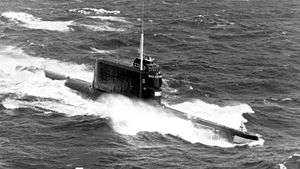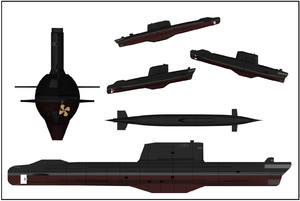Golf-class submarine
 | |
| Class overview | |
|---|---|
| Operators: | |
| Preceded by: | Zulu V class |
| Succeeded by: | Hotel class |
| In service: | 1958–present |
| Completed: | 24 |
| General characteristics | |
| Displacement: |
|
| Length: |
|
| Beam: | 8.2 m (27 ft) |
| Draught: |
|
| Propulsion: | 3 × diesel engines, each 2,000 bhp (1,500 kW); 3 × electric motors, 5,200 shp (3,880 kW); 3 shafts. |
| Speed: | surface - 17 kn, 9.500 nmi/5 kn; submerged - 12kn |
| Range: | 70 days endurance |
| Test depth: |
|
| Complement: |
|
| Armament: | |
Project 629, also known by the NATO reporting name of Golf class, were diesel electric ballistic missile submarines of the Soviet Navy. They were designed after six Zulu class submarines and were successfully modified to carry and launch Scud missiles. All Golf boats had left Soviet service by 1990. All have been since disposed of.[1][2][3] According to some sources at least one Golf-class submarine is operated by China, to test new SLBMs.[4]
Class history
Project 629 was started in the mid-1950s along with the D-2 missile system which it was to carry, and was based on the Foxtrot. Design task was assigned to OKB-16, one of the two predecessors (the other being SKB-143) of the famous Malachite Central Design Bureau,[5] which would eventually become one of the three Soviet/Russian submarine design centers, along with Rubin Design Bureau and Lazurit Central Design Bureau[6] ("Lazurit" is the Russian word for lazurite). The submarine was originally designed to carry three R-11FM ballistic missiles with a range of around 150 km. These were carried in three silos fitted in the rear of the large sail behind the bridge. They could only be fired with the submarine surfaced and the missile raised above the sail but the submarine could be underway at the time. Only the first three boats were equipped with these—the remaining ones were equipped with the longer range R-13 missiles.
The first boats were commissioned in 1958 and the last in 1962.
The boats were built at two shipyards — 16 in Severodvinsk and 7 in Komsomolsk-na-Amure in the Far East. Fourteen were extensively modified in 1966–1972 and became known as 629As by the Soviet Navy and Golf IIs by NATO (the original version having been designated Golf I). The major change was the upgrade of the missile system to carry R-21 missiles which could be launched from inside their tubes with the submarine submerged and increased speed. In later years a few were converted to test new missiles and others had different conversions.
All boats had left Soviet service by 1990. In 1993, ten were sold to North Korea for scrap.[7] According to some sources, the North Koreans are attempting to get these boats back into service.[8]
An organization of defectors from North Korea, named In-Kook Yantai published a report in 2016 entitled “North Korea's Nuclear and WMD Assessment." In that report North Korean defector, Kim Heung-kwang said a 3,500 ton nuclear powered submarine, one of a pair, was due for launch before 2018. It was described as having four missile launch silos in the sail and is generally thought to refer to a re-powered Golf II class vessel.[9][10]
In 1959 the project technology was sold to China which built a single modified example in 1966, which is still in service.

Project Azorian
On March 8, 1968, 1,560 nautical miles (2,890 km) northwest of Oahu in the Pacific Ocean the Golf II class submarine K-129 exceeded its crush depth for unknown reasons and imploded, the accident being registered by the SOSUS network. The entire crew of 98 was lost and the vessel sank with three ballistic nuclear missiles as well as two nuclear torpedoes. The United States recovered parts of the submarine in July 1974 from a depth of around 5 km, in an operation named Project Azorian.[11]
Two nuclear submarines that had been facing retirement, USS Halibut (SSGN-587) and USS Seawolf (SSN-575), were rebuilt and pressed into service as deep sea search vehicles. After Halibut discovered a sunken Soviet submarine containing at least one intact ballistic missile complete with nuclear warhead, Melvin Laird, United States Secretary of Defense under President Richard Nixon, approved Azorian. Six years later, 350 nautical miles (648 km) north of the Hawaiian Leeward Islands, a mechanical claw descended 17,000 feet (5,200 m) to the bottom of the Pacific and, guided by computers on board the Glomar Explorer, clamped onto the mass of twisted, rusting steel and began slowly raising it to the surface. It is unknown for sure how successful the effort was, but the United States has admitted to recovering a portion of K-129, which included six bodies of Soviet sailors that were buried at sea with full honors.[12]
Variants
- Project 629: Original design received NATO reporting name: Golf I, with a total of 22 boats built between 1958 through 1962. Dimension are 98.4 m for length, 8.2 m for beam and 7.85 m for draft. Surfaced/submerged displacement are 2794 / 3553 tons respectively. Surfaced/submerged speed are 15 / 12.5 kn respectively. Project 629 is crewed by 80 men, and is equipped by either D-1 launching system for SS-N-1 or D-2 launching systems for SS-N-4 SLBMs.[13]
- Project 629B: K-229 was converted in 1958 in Severodvinsk, under Project 629B to test newly designed on board missile control system, which was the first generation design fully based on semiconductors.[14]
- Project 629A: 14 Project 629/Golf I class submarines were converted to Project 629A between 1966 and 1972, and received NATO reporting name Golf II. Changes include the increase of dimension, with length and draft increased to 98.9 / 8.5 m respectively, the surfaced/submerged displaced increased to 2300-2820 / 2700-3553 t respectively, surfaced/submerged speed increased to 17 / 14 kn respectively. Crew is increased to 83, and the launching system is D-4 for SS-N-5 SLBMs.[13]
- Project 601: K-118 was converted from 1969 through 1974 and received NATO reporting name Golf III, with displacement increased to 4000 tons and number of SLBMs increased to 6, and the missile is SS-N-8.[13]
- Project 605: K-102 was converted from 1969 through 1973 and received NATO reporting name Golf IV, lengthened 18.3 m with 4 SLBMs to test R-27K (SS-N-13) SLBM.[13]
- Project 619: K-153 was converted in 1976 to test SS-N-20 SLBM, and received NATO reporting name Golf V.[13]
- Project 629R: "K-61", "B-42" and "K-107" were converted in Vladivostok into command posts between 1973 - 1979, with the missile and torpedo tubes removed, received NATO reporting name Golf SSQ.[13]
- Type 6631: Chinese built Golf-class submarine built in Dalian between 1960 and 1966, after receiving technical data from USSR in 1959. China did not purchase SLBM, and thus Type 6631 was equipped with simulation systems and mainly used for training. Originally with pennant number 1101, it was subsequently changed to 200 in 1967. The second unit was supposed to be built and delivered by USSR (pennant number K-208), but due to Sino-Soviet split, most on board equipment was not delivered, and the boat was used as sample for reverse engineering to complete the first unit, which entered Chinese service in August 1966. In June 1968, Type 6631 went through a major refit because China decided to adopt solid fueled SLBM instead of liquid fueled SLBM Soviet used, so the simulation equipment was replaced by support equipment of solid fueled SLBM. In addition, the planned Chinese SLBM had different dimension than the original Russian SLBM equipped Golf class submarine, so the number of missile tubes were reduced to two from the original three.[15]
- Type 031: Type 6631 went through a second major refit which was completed in November 1978. The most important improvement is the ability to launch SLBM underwater. In addition to changing to Type 031 from the original Type 6631, the unit also received the name Great Wall, when China began restore the practice to name its warships in the 1980s. The unit is hence usually referred as Great Wall 200.[16]
References
- ↑ "629 (629)". Retrieved 19 December 2014.
- ↑ "629". Retrieved 19 December 2014.
- ↑ "629". Retrieved 19 December 2014.
- ↑ "Archived copy". Archived from the original on 2012-11-09. Retrieved 2012-09-08.
- ↑ Malachite Central Design Bureau
- ↑ Lazurit Central Design Bureau Archived 2013-08-11 at the Wayback Machine.
- ↑ "CNS - Chronology of North Korea's Missile Trade and Developments: 1994-1995". Retrieved 19 December 2014.
- ↑ "North Korea's Brand New Ballistic Sub Discontinued by Soviets in 1990". 2014-11-04. Retrieved 2014-11-04.
- ↑ defector Kim Heung-kwang, in 2016 report by In-Kook Yantai
- ↑ http://news.joins.com/article/20530031
- ↑ "Project Azorian: The Story of the Hughes Glomar Explorer" (PDF). Studies in Intelligence, CIA. Fall 1985. Retrieved 2010-02-13.
- ↑ Decades Later Details Emerge About CIA Hunt for Soviet Sub
- 1 2 3 4 5 6 "Soviet Golf class submarine". Retrieved 14 April 2013.
- ↑ "Ballistic missile submarines - Project 629". Retrieved 19 December 2014.
- ↑ "6631型G级常规动力弹道导弹潜艇_舰船档案_新浪博客". Retrieved 19 December 2014.
- ↑ Type 031 SSN